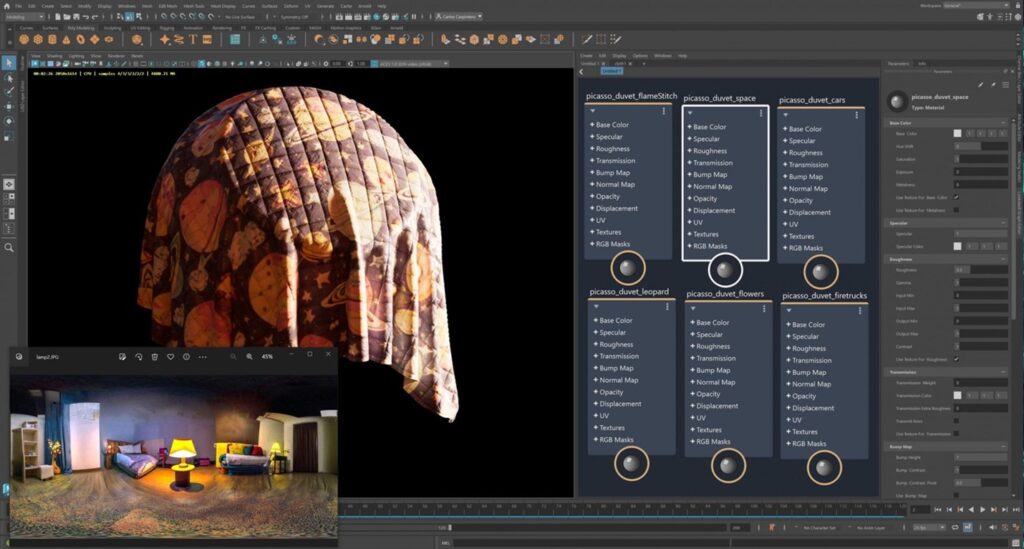If you were wondering when Autodesk was going to climb aboard the generative AI train, well, wonder no more. At Siggraph 2023, the company discussed its work at adding generative AI to two Maya workflow areas: one involving lookdev and the other character animation, the latter occurring through a collaboration with Wonder Dynamics and its Wonder Studio. Autodesk will be using Nvidia’s Picasso for the AI development.

What do we think? A few decades ago, computers changed the way art and animation were created. CGI obviously altered the animation landscape, but the process of 2D animation was radically changed as well, as artists were given the means to streamline their work in this medium. Did these tools have a negative impact on the creative aspect of the art itself? Most would say no. We need to think of generative AI in the content creation process with a similar lens. There is a creative aspect and a rote aspect when it comes to artwork and animation. Having AI perform the rote work does not diminish any creative input. I guarantee that with AI tools, I will not be able to generate an image on par with an artist from Pixar. Artists and animators are under tremendous pressure to raise the bar with ever more complexity and to do so in less time than before. Using AI within their DCC tools, including Maya, will enable artists to be more creative by enabling them to iterate faster and unlock their vision like never before. Will AI forever change the DCC landscape? Yes. Will it be for the better? We expect that to be so once we get over our Luddite-like view when it comes to art.
Autodesk tackles generative AI, continues to focus toward open standards
Autodesk, a leading DCC tool vendor, did not have any big software updates to show at Siggraph 2023. However, the company did have some interesting, although not quite unexpected, news, revealing the first steps it is taking toward integrating generative AI into Maya and is using Nvidia’s Picasso for this trek.
There was no getting around the topic of generative AI at Siggraph 2023, the buzziest tech at the conference, and Autodesk used its annual press dinner to discuss a pair of initial workflows that is kicking off its AI journey as it brings this burgeoning technology into its widely used Maya modeling and animation software.
Autodesk iterated what we have been hearing from other DCC tool companies, that generative AI can assist content creators in their workflow, as opposed to commandeering it. As Autodesk embarks on its generative AI journey, the company is using Nvidia’s Picasso to integrate its generative AI services into Maya. A cloud-based service, Picasso is used to build and deploy generative AI-powered models and can be used to train foundation models with proprietary data for building applications that use natural text prompts to quickly create and customize visual content—text-to-3D, if you will.
The first area Autodesk is tackling with Picasso is focused on look development, specifically for dynamically generating textures, materials, and HDR images directly into LookdevX in Maya, which will dramatically speed up look development and scene lighting workflows. LookdevX, introduced in Maya 2024 this past March, is a new USD-based toolset for creating USD shading graphs in Maya, resulting in a consistent look development across products and platforms.
Eric Bourque, Autodesk’s VP of content creation for M&E, said the company looks at generative AI as a compelling albeit additional tool for artists to use, enabling them to iterate and explore various concepts and ideas at a rapid pace. And once the creative idea is reached and artists get to a first draft with AI, they can then refine that work by using traditional tools.
But Autodesk, like others including Adobe, expressed concern over the ethical aspects of data that is used for AI training, and said it will work toward this responsibly and ethically integrating AI into 3D content creation for characters and worlds.
Insofar as character animation is concerned, Autodesk is teaming with Wonder Dynamics, maker of Wonder Studio, an AI tool that automatically animates, lights, and composes CG characters into a live-action scene. This will give artists that extra boost during character-driven VFX workflows. Exactly what this will entail, Autodesk is not saying, other than to confirm that it is working working with Wonder Dynamics to help users move data seamlessly between Maya and Wonder Studio.
No time frame has been divulged for any of the generative AI work.
In other news, Autodesk continued its focus on open standards. Just prior to Siggraph, Autodesk joined Pixar, Adobe, Apple, and Nvidia as founding members of the Alliance for OpenUSD (AOUSD) by the Joint Development Foundation, which is an affiliate of The Linux Foundation. USD is an open and extensible framework and ecosystem for describing, composing, and interchanging 3D CG data. USD takes a non-destructive approach to editing, generating a hierarchical data structure that makes it easier to exchange data created in various DCC applications. The AOUSD will work to develop and advance OpenUSD across a broad range of industries.
At Siggraph, Autodesk also discussed its collaboration with Adobe on Open Physically-Based Rendering (OpenPBR), a new open-source shading model that offers a more intuitive way of moving from one software program to another. This subproject of MaterialX builds on that standard for representing look development content by describing how an artist interfaces with the physical properties of the surface they are creating. As a result, artists have a more specific interface with which to work and can transfer data among assets with very little conversion required.
OpenPBR is an open-source specification under the Academy Software Foundation. It is the successor to two similar but somewhat different specs: Autodesk Standard Surface and the Adobe Standard Materials. Going forward, Autodesk and Adobe will focus their efforts on OpenPBR.